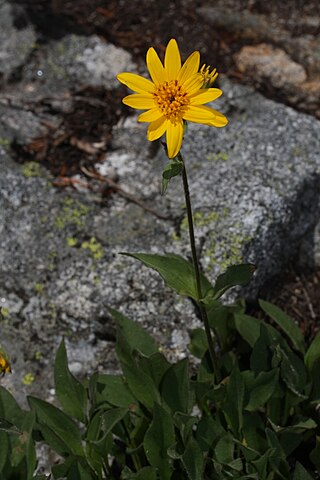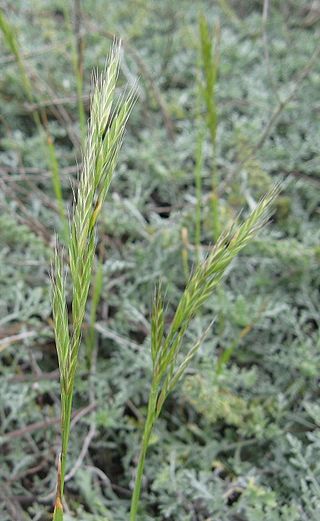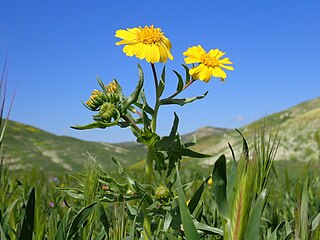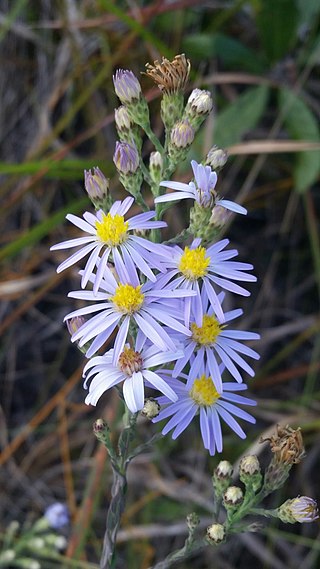
Gaillardia pulchella is a North American species of short-lived perennial or annual flowering plants in the sunflower family.

Quercus shumardii, the Shumard oak, spotted oak, Schneck oak, Shumard red oak, or swamp red oak, is one of the largest of the oak species in the red oak group. It is closely related to Quercus buckleyi, Quercus texana, and Quercus gravesii.

Coreopsis nuecensis, the crown tickseed, is an annual, herbaceous, flowering plant in the Asteraceae family. It is native to Texas, and probably Tamaulipas. There are reports of isolated populations in Michigan and Florida, both probably escapes from cultivation.

Symphyotrichum chilense is a species of flowering plant in the family Asteraceae known by the common names Pacific aster and common California aster. It is native to the west coast of North America from British Columbia to Southern California and the Channel Islands. It grows in many habitats, especially along the coast and in the coastal mountain ranges. Despite its scientific name, it does not occur in Chile. Pacific aster blooms from June to October with violet ray florets surrounding yellow disk florets.

Arnica mollis, the soft arnica or hairy arnica, is a perennial herbaceous flowering plant in the family Asteraceae. It is native to Canada and the United States. There may be a disjunct population of this species in Coös County, New Hampshire. The species grows in subalpine mountain habitat such as meadows and streambanks.

Bromus arizonicus is a species of annual brome grass known by the common name Arizona brome.
Liatris cymosa, also known as Aggie-land gayfeather or branched blazing star, is a plant species in the family Asteraceae and genus Liatris. It is native to east central Texas in North America, where it is found in habitats such as post oak woodlands, fields, fence rows, woodland openings and edges, in clay soils. It blooms in mid to late summer with purple flower heads. It is of conservation concern due to habitat loss.

Liatris elegans, known commonly as pinkscale gayfeather, pinkscale blazingstar, and elegant blazingstar, is a species of flowering plant in the family Asteraceae. It is native to the southeastern United States as far west as Texas and Oklahoma.

Symphyotrichum pilosum is a perennial, herbaceous, flowering plant in the Asteraceae family native to central and eastern North America. It is commonly called hairy white oldfield aster, frost aster, white heath aster, heath aster, hairy aster, common old field aster, old field aster, awl aster, nailrod, and steelweed. There are two varieties: Symphyotrichumpilosum var.pilosum, known by the common names previously listed, and Symphyotrichumpilosum var.pringlei, known as Pringle's aster. Both varieties are conservationally secure globally and in most provinces and states where they are native.

Aphanostephus (dozedaisy) is a genus of flowering plants in the family Asteraceae.

Madia gracilis is a species of flowering plant in the family Asteraceae known by the common names grassy tarweed, slender tarweed, and gumweed madia.

Madia radiata is a species of flowering plant in the family Asteraceae known by the common names golden madia and showy madia. It is endemic to California, where it is known mostly from the Central Coast Ranges and adjacent edges of the San Francisco Bay Area and Central Valley.

Madia sativa, known by the common names coast tarweed and Chilean tarweed, is a species of flowering plant in the family Asteraceae found in parts of western North and South America.

Wyethia angustifolia is a species of flowering plant in the family Asteraceae known by the common names California compassplant and narrowleaf mule's ears. It is native to the west coast of the United States from Washington to California, where it grows in grassland, meadows, and other open habitat. It is a perennial herb growing from a tough taproot and caudex unit and producing a stem 30 to 90 centimeters tall. The leaves have lance-shaped blades up to 50 centimeters tall. The inflorescence produces one or more large sunflower-like flower heads at the top of the hairy stem. The head has narrow, hairy phyllaries at the base. It contains up to 21 yellow ray florets each up to 4.5 centimeters long and many yellow disc florets. The fruit is an achene which may be nearly 2 centimeters long including its pappus.

Aphanostephus ramosissimus is a North American species of flowering plants in the family Asteraceae, with the common name plains lazydaisy. It is native to the southwestern and south-central United States, the states of Arizona, New Mexico, Texas, and Oklahoma, as well as to central and northern Mexico as far south as Puebla and Michoacán.
Bidens heterosperma, commonly known as the Rocky Mountain beggarticks, is an annual or perennial, herbaceous, flowering plant in the family Asteraceae, tribe Coreopsideae. It is native to northwestern and north-central Mexico, and portions of the southwestern United States.

Bradburia pilosa, the soft goldenaster, is a North American species of flowering plants in the family Asteraceae, native to the south-central United States, primarily the southeastern Great Plains and lower Mississippi Valley, in the states of Texas, Oklahoma, Kansas, Missouri, Arkansas, Louisiana, Tennessee, Mississippi, and Alabama. Additional populations are reported farther east but these appear to be introductions. Its habitats include disturbed roadsides and pine-oak-juniper woods.

Cirsium texanum is a species of plant in the tribe Cardueae within the family Asteraceae found in North America. Common names include Texas thistle, Texas purple thistle or southern thistle. The species is native to northern Mexico and the southern Great Plains of the south-central United States. It grows in prairies and roadsides.

Symphyotrichum racemosum is a species of flowering plant native to parts of the United States and introduced in Canada. It is known as smooth white oldfield aster and small white aster. It is a perennial, herbaceous plant in the family Asteraceae. It is a late-summer and fall blooming flower.

Symphyotrichum adnatum is a species of flowering plant in the family Asteraceae native to the southeastern United States and the Bahamas. It is a perennial, herbaceous plant that may reach 30 to 120 centimeters tall with flowers that have lavender ray florets and yellow disk florets. The common name scaleleaf aster has been used for this species.


















